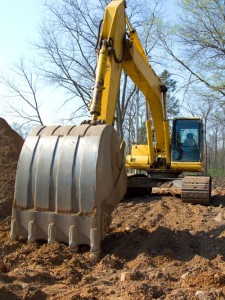Going Beyond Minimum Requirements
is 
Septic systems are no fun. They don’t amaze or entertain, so it’s no wonder people don’t often choose to go beyond the minimum requirements set forth by the local Health Department.
The following are some suggestions to “better” your septic system, giving it the best chance to have a long and prosperous life. Check with your local Health Department to make sure these are options where you live.
To function properly, any septic system must be properly maintained. Be sure to review my Care and Maintenance Page before you read any further.
To Improve Your Septic System:
- Install a SludgeHammer system to clean your wastewater before it goes into your absorption field
- Choose a larger septic tank or two tanks in series
- Increase the size of your field system beyond the minimum requirements
- Put in two fields with an alternating valve to switch between them every year
- Utilize time-dosing for your pumped system
- Install a Sim-Tech pressure filter on your pump system
- Design your mound system with 24″ of sand under the gravel bed
Install a SludgeHammer Treatment System Unit:
My joint venture Meade Septic Supply, LLC is the Principal distributor for SludgeHammer in Indiana. A SludgeHammer system is the ultimate addition to your septic system. What is left after treatment is cleaned water that is unable to produce or support a bio-mat in your absorption field. In fact, adding a SludgeHammer system can revive your existing system by combating the existing bio-mat. Contact me to see if your existing system is a candidate for adding SludgeHammer technologies.
Visit my Meade Septic Supply LLC website to find out more. Be sure to compare SludgeHammer with other types of secondary treatment type devices. If you compare technologies, simplicity of installation and maintainance, power requirments and cost SludgeHammer comes out on top every time.
Larger septic tank or two tanks in series
In a septic tank, liquid sewage goes through a physical settling process which is assisted by bacteria. The larger tank you have, the longer it takes for the wastewater to make it’s way through the tank. The longer it’s in the tank, the more likely suspended solids and debris are to sink to the bottom and become part of the sludge layer. On the other hand, fats oils and greases will rise to the surface to become part of the scum layer. Remember, your septic tank draws water from the center third contents of your septic tank where the liquid effluent is.
Adding a two compartment tank or two septic tanks in series further enhances this settling/separation process and helps to keep suspended material from making it’s way into your field system where it can clog the soil interface and feed (and promote) the bio-mat.
Increase the size of the field system beyond the minimum requirements
People forget that septic system have a life span. How long your absorption field lasts is a function of the amount and strength of water your put into your system. Eventually, a bio-mat formation will slow your system’s ability to absorb until, one day, you put water into your system faster than the field can absorb it, causing your system to back up. Whether, your absorption field is a mound or trench system, making the absorption field larger than the health department requires is a simple and affordable way to get extra life out of your system.
Put in two fields on an alternating valve and switch between them every year
Most Health Departments will allow you to install two full sized gravity absorption fields and then switch between each system yearly using a Bull Run Valve. This allows one side of the absorption field to rest while the other one is being used. Using a valve between the fields will greatly extend the life of your system. Just be sure to remember to switch your valve!
Install time dosing on you pump system
People generate wastewater unevenly throughout the day. These irregular flows are called surge flows. In a home, the first surge of wastewater occurs in the morning when showers and toilets are used and breakfast is prepared. Another surge flow then occurs in the evening when people get home from work (and school) and prepare dinner, do laundry, etc.
Septic systems (especially aging ones) don’t handle these surge flows well and sometimes back-up temporarily while these large mounds of water are being sent to the field system.
Time dosing is a technique to eliminate surge flows by evenly spreading out your daily wastewater flow through dosing throughout the day on a time basis instead of using demand dose. Time dosing is good for your system and can be utilized with any system that has a pump.
How it works (simply put):
The timer in the control panel is told when to dose (e.g. every two hours).
When water rises in your dosing tank, it raises your on float but instead of turning on the pump, it turns on the timer. Once the timer has been on for two hours, it turns on the pump for a specified amount of time or until the on float reaches it’s “Off” position. This sends water to your absorption field every two hours (24 hours a day) and eliminates the problematic surge flows.
To be effective, time dosing tanks should be larger than normal dosing tanks to enable storage of the surge flow between doses.
Install a Sim-Tech pressure filter on your pump system
Sim-Tech pressure filters are a great way to protect the small 1/4″ dia. holes in your pressure distribution laterals from getting clogged with lint, hair and other suspended objects. Repairing a clogged pressure distribution network is expensive, messy and often ineffective. I recommend a Sim-Tech pressure filter on all of the mound systems that I design. Watch their 5 minute demonstration video and you will be convinced.
Design your Mound System with 24″ of Sand Under the Gravel Bed
Mound septic systems provide a marginal amount of wastewater treatment as it passes through the medium sand under the gravel bed. Research shows that more sand will give you more treatment (cleaner water) . Of course, the best way to clean your water is to utilize a secondary treatment device such as a SludgeHammer system to clean your water before it is sent to your mound absorption field but, if you do not choose to install an ATU, you should consider adding extra sand. Indiana regulation’s require a minimum of 12″ of sand under the gravel bed, but 24″ is better, giving you more treatment than 12″. Just be sure your system is designed and your pump is sized to handle the extra static lift created by the additional sand.
